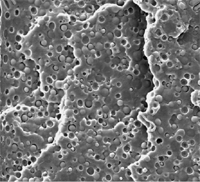
 |
|
Recent Research Developments |
|
| Index of Recent Research News |
|
Nov 13, 2002 |
|
|
|
Polylactide is a biodegradable aliphatic polyester derived from renewable resources that has gained much interest in recent years. Currently, polylactide is primarily used for biomedical applications such as sutures and drug delivery devices. However, the fact that polylactide is derived from renewable resources makes it attractive from an environmental standpoint. Polylactide could become a competitive alternative to traditional commodity plastics for everyday applications. Unfortunately, broad substitution of polylactide is thwarted by its brittle behavior under impact loads. In analogy to other brittle materials, polylactide can be toughened by blending with other polymers. However, the mechanical performance of a two-phase polymer systems is generally limited due to the low degree of interfacial adhesion and the large minor phase particle size that result from the inherent immiscibility of most polymer pairs. This limitation can be overcome through the addition of a corresponding block copolymer, which acts as a compatibilizer. In a study led by graduate student Kelly Anderson working with Professor Marc Hillmyer, melt blends of semi-crystalline polylactide with semi-crystalline linear low-density polyethylene were examined as toughened polylactide composites (submitted to J. Appl. Polym. Sci.). Unexpected toughening was achieved in these binary blends as evidenced by the remarkable improvement in the impact strength of these hybrid materials; the impact strength increased from 22 J/m for the parent polylactide to 350 J/m for an 80/20 polylactide/polyethylene blend. Furthermore, polyethylene-polylactide block copolymers, prepared by a methodology developed in Professor HillmyerÍs lab (see: Wang, Y.; Hillmyer, M. A. - Polyethylene-Poly(l-Lactide) Diblock Copolymers: Synthesis and Compatibilization of Poly(l-Lactide)/Polyethylene Blends - J. Polym. Sci., Part A: Polym. Chem. 2001, 39, 2755), were used in these blends to improve the polyethylene particle dispersion and resulted in additional increases in the toughness (650 J/m!) and improvement in the batch-to-batch reproducibility. We are currently investigating the mechanism responsible for toughening in these semi-crystalline/semi-crystalline binary and ternary blends. These hybrid materials will ultimately be useful for applications that require strength not found in the parent polylactide materials. We hope to extend what we learn in these systems to prepare composites that contain 100% renewable resource materials. |
|

|
|
|
|
* This page is updated every two weeks.
Next scheduled update: Nov. 27, 2002.
The University of Minnesota is an equal opportunity educator and employer. Copyright 2003 by the Regents of the University of Minnesota. For questions or comments, contact the Chemistry Webmaster.
|